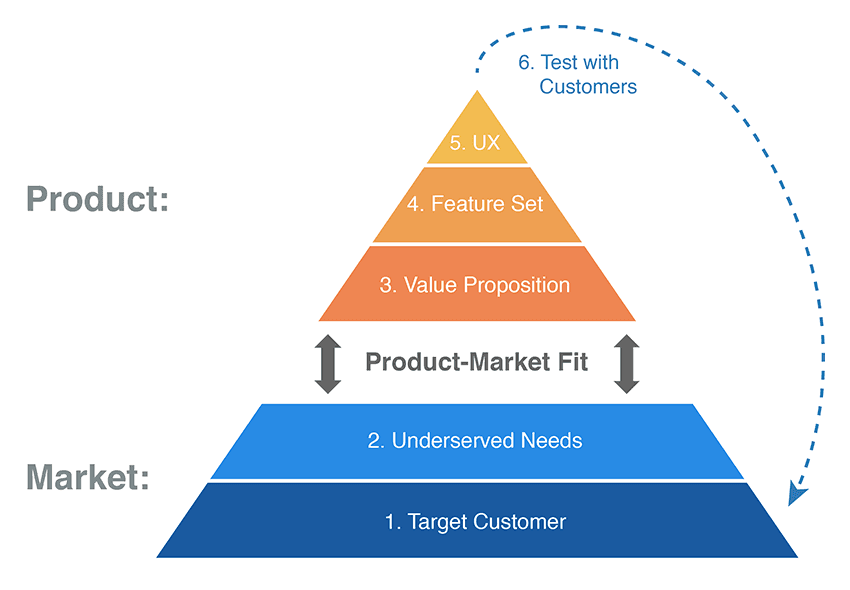What is product-market validation?
Most product ideas sound great when we’ve created them in our minds, but several fail the minute they reach a customer’s hands. Since joining the market with a new product is always a risk, real-life user testing is a critical pre-launch task. Product market validation is about minimizing risk and validating a product concept within its target market.
Why is it important?
Accurately executed market validation techniques reduce reliance on personal bias and gut “feelings”. Though often sacrificed due to time and budget constraints, the majority of the time product development will have more success in reaching the right users with the right features, when sound user research and product validation has been employed throughout the project process.
Do whatever is required to get to product-market fit. Including changing out people, rewriting your product, moving into a different market, telling customers no when you don’t want to, telling customers yes when you don’t want to, raising that fourth round of highly dilutive venture capital — whatever is required.
Marc Andreessen
6 Steps to Product-Market Fit
The Product-Market Fit Pyramid is an excellent 6 steps hierarchical template for completing the process of product-market validation and achieving product-market fit. Created by Dan Olsen, and outlined in his well-known, well-loved book – The Lean Product Playbook.
Throughout this blog, we will identify and explain each step of the Lean product process using examples and providing techniques for applying these steps successfully.

MARKET
- Identify your target market/customer: The first layer of the pyramid and first step in any good market validation plan includes a deep dive into the actual market. We often default to assumptions, gut, and “I feel” statements. We consider our target market to be much too varied. To ascertain the real attributes of our target audience we work through a few exercises.
- User Personas and Customer Journey Maps: Have we determined our ideal client profiles? Have we created a semi-fictional representation of that customer (user persona)? What will our ideal clients care about? How will they use the app/website/product? We can garner this information by completing interaction workshops and customer journey mapping. In creating user flows, our goal is to show how a prospective user will experience the website or application and reveal any potential challenges.
- Identify underserved customer needs: These are the needs in the market that aren’t currently being served. For example, before Uber existed, if you needed a ride to the airport, your sole option was to call up a yellow taxi (or green, blue, maybe even pink too). The identified target customers for Uber could be people in a hurry, business professionals, or city dwellers that don’t own their own vehicles (just to name a few). However, for each of those identified target customers, the underserved need is different. For a user without a car of their own, the underserved need is that he/she has no other option. Alternatively, the underserved need could be a price factor, ie. “this exists, but it’s too expensive” OR “we can’t afford it, we need it for less”.
PRODUCT
By now, you know the target customer/s. You know what their needs are and how they are not being met. We’ve documented these things in the user persona deck created during our examination of the “Market”.
- Value Proposition: At the bottom of the “Product” level of the Product/Market Fit Pyramid, is the value proposition. It explains the value provided; I.e. “this is what the product solves” OR “this is how we are serving the unmet need”.
A value proposition should speak to the pain points of the target audience. For example, let’s look at Lyft. As it joined the shared-ride scene it needed a differentiator, a unique value proposition. Lyft needed something that set them apart from the competition.
Let’s say that a potential driver user persona for Lyft looked like this: John, 25 years old, enjoys sleeping in, wants to be his own boss. He’s easily frustrated with rideshare services because they take too high of a monetary percentage from each ride. A simple value proposition for John could look like: “With Lyft, we only take 5% of every ride” OR “With Lyft, you keep 100% of the ride fare and simply split the tip with us.” The key to a value proposition is for it to be more favorable than alternatives for your target audience.
Customers don’t care about your solution. They care about their problems. Keeping problem space and solution space separate and alternating between them as you iteratively test and improve your hypotheses is the best way to achieve product-market fit.
Dan Olsen, an excerpt from his book The Lean Product Playbook
- Feature Set: With an understanding of how the customer needs aren’t being met and what the differentiator and value proposition are for the product, you can accurately define the feature set. A thorough understanding of the value proposition and underserved customer needs allows you to problem-solve for users through the feature set.
To explore this further; let’s review our rideshare example again. In our prior hypothetical, Lyft broke onto the rideshare scene competing for the attention of drivers. However, it’s time for Uber to fight back. Their team has determined that riders are unable to easily locate their driver as they are waiting for their ride. Users are upset and the issue has become a point of contention. Uber can solve this problem by building a new feature. When a user opens a map and summons a car, Uber’s app will now show the rider a real-time GPS location of the driver’s car coming towards them – problem solved.
A feature set works toward the fulfillment of the value proposition which serves the unmet needs of the target customer. Every time you introduce a new element of the triangle it sits on top of and is informed by the foundational elements. - User Experience The last tier of the triangle prior to testing is UX. User experience is the visual culmination of everything discovered in the tiers beneath it. It is what we use to validate and test the value proposition and feature set created with the target audience’s unmet need in mind.
TESTING
Testing is utilized to gather feedback from the user base about the validity of the product concept. Building an early, interactive design and putting it in front of test groups gives us invaluable information about what the product is doing well and what it might be lacking. Testing like this can take place in several different environments; 1:1 user interviews, living room style focus groups, and even user surveys can be great quantitative tools to measure engagement, preference, and perception.
By giving testers an opportunity to rank features, you get an idea of the current feature sets they care about and missing features that they would like to see included in your product. Living room style user testing works well to gauge user reaction. Typically, potential users come into the “living room” and cameras are set up to record the entire session. You give the audience visual aids, a prototype, whatever it is that gives a broad conceptual view of your product without coloring user opinion.
The goal with user testing is not to reach a desired conclusion, but to reach an honest conclusion.
When testing a product concept we don’t add context so as not to jeopardize the validity of the test. The demo should speak for itself.
Wrap Up
The goal of product-market validation is to meld the market characteristics (your target demographic and their underserved needs) together with the product characteristics (value proposition, features, and user experience).
Ultimately, your team should never feel pressure to launch with a perfect product. Your minimum viable product (MVP) would be something you are reasonably sure can be that foothold that allows you to evolve, grow, and iterate. The users you gather at launch provide you with an opportunity to measure your product’s impact on real people. Releasing an MVP turns your startup idea into a reality that can be iterated on in a very scientific way. Why will users buy your product? Why won’t they? What do they like about your product? What do they dislike?
Market validation is the process of validating an idea, but once an MVP is launched the iterations shouldn’t stop, you should continue to augment and improve the product as user feedback suggests.
Singlemind is an awarded software design and development agency in Portland, OR. We serve enterprises, innovative startups, and non-profit organizations around the globe. Our diverse, agile team has more than 15 years of success in designing and developing digital products (mobile apps, websites, web apps, etc). Our goal is to help businesses thrive in today’s ever-evolving, omnichannel world of technology.

